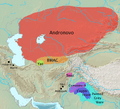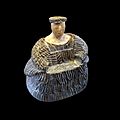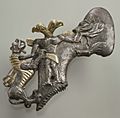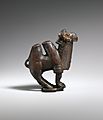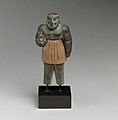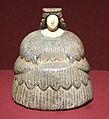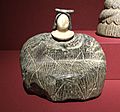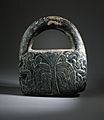Bactria–Margiana Archaeological Complex facts for kids
The Bactria–Margiana Archaeological Complex (or BMAC), also known as the Oxus civilization, is the modern name for an ancient culture from the Bronze Age in Central Asia. This civilization existed from about 2300 to 1700 BCE.
It was located in areas that are now Turkmenistan, northern Afghanistan, northeastern Iran, southern Uzbekistan, and western Tajikistan. A Soviet archaeologist named Viktor Sarianidi first discovered and named these sites in 1976. Bactria was the Greek name for an area in northern Afghanistan, and Margiana was the Greek name for a region in today's Turkmenistan.
Sarianidi's discoveries were mostly reported in Soviet journals. People in the West did not know about these findings until his work was translated in the 1990s.
Contents
How the BMAC Began
Archaeologists have found signs of early settlements in the northern foothills of the Kopet Dag mountains. This was during the Neolithic period, which was a very early time when people started farming.
At a site called Jeitun, people lived in mud brick houses around 6000 BC. These early inhabitants were farmers. They raised goats and sheep and grew crops like wheat and barley. They likely came from southwest Asia. The Jeitun site gives its name to the entire Neolithic period in this area. Later, at another site called Chagylly Depe, farmers started growing crops that needed irrigation, like a special kind of bread wheat. This became common during the Copper Age.

During the Copper Age, more people lived in this region. Some archaeologists believe people moved here from central Iran, bringing new skills like working with metals. These newcomers likely mixed with the local farmers. However, other studies suggest there was a clear break in settlement between the late Neolithic and early Copper Age.
Growing Settlements
Large Copper Age settlements grew at places like Kara-Depe and Namazga-Depe. Smaller settlements also appeared. Around 3500 BC, the culture in this area started to show two different styles of pottery. This might mean that two different groups of people were forming.
Around 3000 BC, people from one of these groups, from the Geoksiur Oasis, moved east. They settled in new areas, including the Murghab delta and the Zerafshan Valley. Pottery from Geoksiur was found in these new places. Farmers from Iran, Turkmenistan, and Afghanistan were connected by these scattered farming communities.
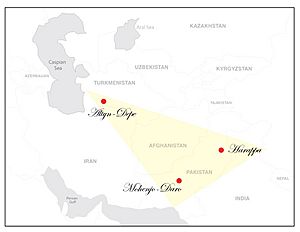
In the Early Bronze Age, the settlements in the Kopet Dag oases, like Altyn-Depe, grew into early cities. People started using pottery wheels and growing grapes. The BMAC culture reached its peak around 2300 BC during the Middle Bronze Age. This is when it became known as the Bactria–Margiana Archaeological Complex.
Life in the BMAC
The people of the BMAC culture were settled farmers. They used irrigation to grow wheat and barley. They had an impressive culture with large buildings, tools made of bronze, beautiful pottery, and jewelry made from valuable stones. These features show that the BMAC was a true civilization.
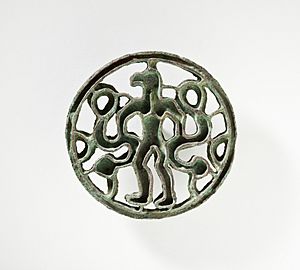
Archaeologists believe that Gonur was the "capital" city of the BMAC in the Margiana region. Many large structures have been found and studied. For example, the palace at north Gonur was huge, measuring 150 by 140 meters. There was also a temple at Togolok and a fort at Kelleli. These buildings had strong walls, gates, and supports. They were very well built.
The BMAC people were skilled at working with different metals. They used bronze, copper, silver, and gold to create many objects. Many metal artifacts have been found at their sites. They also built large irrigation systems, especially at the Geoksiur Oasis, to help with farming.
Transport and Mystery
Models of two-wheeled carts found at Altyn-Depe show that wheeled transport existed in Central Asia around 3000 BC. These early carts were likely pulled by oxen or bulls. Later, around 2200 BC, people in the BMAC started using camels. A model of a camel-drawn cart was found at Altyn-Depe.
In 2000, a tiny stone seal was found at the BMAC site of Anau in Turkmenistan. It had geometric marks that looked like ancient Chinese writing. This led some people to wonder if the BMAC also had its own writing system. However, the marks on the Anau seal are much older than the Chinese characters they resemble, so it remains a mystery.
Images for kids
-
Archaeological cultures associated with Indo-Iranian migrations (after EIEC). The Andronovo, BMAC and Yaz cultures have often been associated with Indo-Iranian migrations. The GGC (Swat), Cemetery H, Copper Hoard and PGW cultures are candidates for cultures associated with Indo-Aryan migrations.
-
Female figurine of the "Bactrian princess" type; between 3rd millennium and 2nd millennium BC; chlorite mineral group (dress and headdresses) and limestone (face and neck); height: 17.3 cm, width: 16.1 cm; Louvre
-
Axe with eagle-headed demon & animals; late 3rd millennium-early 2nd millennium BC; gilt silver; length: 15 cm; Metropolitan Museum of Art (New York City)
-
Female figurine of the "Bactrian princess" type; between 3rd millennium and 2nd millennium BC; grey chlorite (dress and headdresses) and calcite (face); Barbier-Mueller Museum (Geneva, Switzerland)
-
Handled weight; late 3rd–early 2nd millennium BC; chlorite; 25.08 x 19.69 x 4.45 cm; Los Angeles County Museum of Art (USA)
See also
 In Spanish: Complejo arqueológico Bactria-Margiana para niños
In Spanish: Complejo arqueológico Bactria-Margiana para niños



